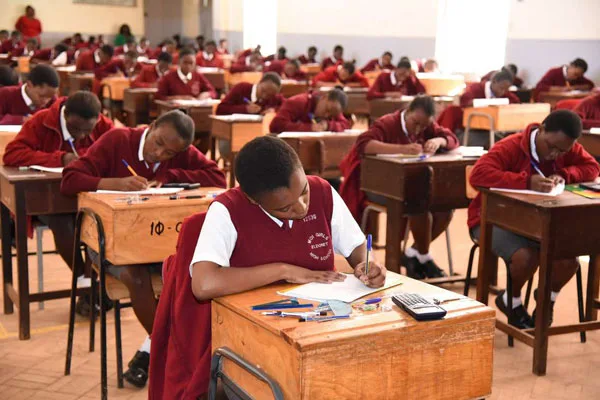The High Cost of Education vs. Low Success Rates: Are We Funding Success or Failures?
Recent data from the Kenya Certificate of Secondary Education (KCSE) paints a stark picture of academic performance in public schools.
Out of 962,000 candidates who sat for the 2024 KCSE, only 246,000, or 26%, attained grades between C+ and A, qualifying for university admission.
Conversely, 74% of candidates scored below a C+, rendering them ineligible for higher education entry.
Performance varies significantly across different categories of schools. National schools, which enroll only 4% of secondary students, contributed 14% of the university qualifiers.
Extra-county schools, with 21% of the student population, accounted for 40% of the qualifiers. County schools, housing 15% of learners, produced 14% of university-bound students.
Sub-county schools, which enroll the majority (54%) of students, contributed just 25%. Private schools, representing 6% of learners, contributed 7% of qualifiers.
| School Category | % of Learners | Contribution to University Qualifiers | Qualifying for University | Not Qualifying |
|---|---|---|---|---|
| National | 4% | 14% | 83% | 17% |
| Extra County | 21% | 40% | 51% | 49% |
| County | 15% | 14% | 23% | 77% |
| Subcounty | 54% | 25% | 12% | 88% |
| Private | 6% | 7% | 30% | 70% |
Non-Qualifiers and Distribution by School Category
The distribution of non-qualifiers reveals even more disparities. Sub-county schools, which primarily cater to rural day scholars, accounted for 64% of students who failed to meet the C+ threshold.
County schools followed with 15%, while extra-county schools and private schools contributed 14% and 6%, respectively. National schools had the smallest proportion of non-qualifiers at just 1%.
| School Category | Non-Qualifiers (%) | Key Insights |
|---|---|---|
| National Schools | 1% | Minimal non-qualifiers. |
| Extra County Schools | 14% | Moderate contribution. |
| County Schools | 15% | Significant non-qualifiers. |
| Subcounty Schools | 64% | Highest proportion of failures. |
| Private Institutions | 6% | Low contribution to non-qualifiers |
Grade Quality Across School Categories
A closer analysis of grade distribution underscores the disparities in academic achievement. For the top grade of A, only 1,693 students achieved this nationwide.
National schools produced 81% of these, while extra-county and county schools accounted for the remaining share. Sub-county schools contributed less than 1%.
Similarly, for A-, which was awarded to over 7,700 students, national schools contributed 60%, and extra-county schools 27%.
County and sub-county schools accounted for only 2% and 4%, respectively. In the case of grades like B+ and B, extra-county schools had the highest share, while county and sub-county schools lagged behind significantly.
In stark contrast, sub-county schools dominated the lower grades, with 74% of students scoring E to D+ coming from these institutions. This indicates performance challenges in schools catering to rural populations.
Financial Investment in Education (Budget Allocation)
The financial year 2023/2024 saw the Kenyan government allocate significant funds to education. Free Day Secondary Education (FDSE) received KSh 62.6 billion, and the Teachers Service Commission (TSC) was allocated KSh 38.2 billion.
The total expenditure on basic education from primary to Form Four stood at KSh 142.2 billion, with an estimated cumulative cost of KSh 500 billion to educate the 2024 KCSE cohort from Standard One through Form Four.
| Financial Year | Free Day Secondary Education (KES) | TSC Allocation (KES) | Total Basic Education Funding (KES) |
| 2023/2024 | 62.6 billion | 38.2 billion | 142.2 billion |
| 2024/2025 | 61.9 billion | 38.2 billion | 142.2 billion |
Cost vs. Outcomes
Despite significant financial investment, the results show limited returns. For instance, 74% of learners scored below C+, with subcounty schools contributing the majority of these low-performing students.
A significant 88% of students in day schools scored below C+, with 69% scoring D+ and below.
Over KES 500 billion was spent to educate the cohort from Standard 1 to Form 4, yet the outcomes highlight inefficiencies in resource utilization.
These outcomes prompt a broader discussion about the efficiency and impact of education funding in Kenya.
Read Also: The Decline of Public University Education in Kenya
Conclusion: Value for Money?
The data highlights persistent disparities in performance across school categories, with national and extra-county schools dominating the top grades, while sub-county schools struggle to produce university qualifiers.
Given the substantial financial outlay on education, stakeholders must evaluate the effectiveness of resource allocation and explore strategies to ensure equitable access to quality education for all learners.
The High Cost of Education vs. Low Success Rates: Are We Funding Success or Failures?
Follow Teachers Updates on Facebook, LinkedIn, X (Twitter), WhatsApp, Telegram, and Instagram. Get in touch with our editors at [email protected].


Discussion about this post